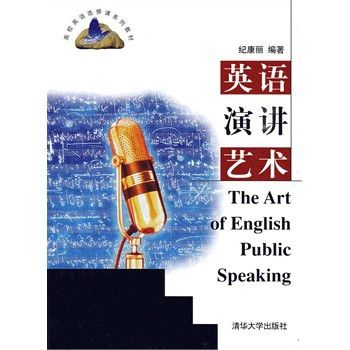《英語演講藝術》是2009年清華大學出版社出版的圖書,作者是紀康麗。
基本介紹
- 中文名:高校英語選修課系列教材·英語演講藝術
- 作者:紀康麗
- 出版社:清華大學出版社
- 出版時間:2009年10月01日
- 頁數:314 頁
- 定價:32 元
- 開本:16 開
- ISBN:9787302211198
- 語種:簡體中文 英語
- 叢書系列:高校英語選修課系列教材

《英語演講藝術》是2009年清華大學出版社出版的圖書,作者是紀康麗。
《英語演講藝術》是2009年清華大學出版社出版的圖書,作者是紀康麗。內容簡介《英語演講藝術》是作者在多年的教學實踐中,經過不斷摸索反覆修改而完成的。全書共有17個章節,每個章節均包含以下幾大主要部分的內容:概述、演講知識...
《英語演講藝術》是2012年07月華中科技大學出版社出版的圖書,作者是劉諾亞。內容簡介 《普通高等教育英語“十二五”規劃教材:英語演講藝術(附光碟)》宗旨:老師快樂地教,學生快樂地學!作者將十餘年來珍藏的影視演講資料傾心奉獻!本書...
《英語演講藝術》是2015年12月對外經濟貿易大學出版社出版的圖書,作者是劉宇紅、董曉波。內容簡介 This book has a considerably rich content, covering a comprehensive introduction to rhetoric, a detailed history of rhetoric, ...
《英語演講藝術入門》是廈門大學出版社出版的圖書,作者是紀玉華。內容簡介 本書介紹了英語演講的分類、演講者的素質等基本知識,怎樣選擇語調、變換語氣傳情達意的基本訓練方法和基本理論,並對中外名家及大學生的成功演講進行了點評。
《演講的藝術2012》是2010年外語教學與研究出版社出版的圖書,作者是斯蒂文·E.盧卡斯。內容簡介 《演講的藝術2012》是作者專為中國英語演講學習者量身定製,既保留原書精髓,又融入中國特色,更具實用性與適用性。《演講的藝術2012》系統...
閱讀《普斐特英語慢閱讀:像他們那樣激情演講》,可以激發思考,開闊視野,提高英文演講水平。內容介紹 《普斐特英語慢閱讀:像他們那樣激情演講》是一種機智幽默激勵人心的藝術,它把社會文化、遵德倫理、政治軍事等有機融匯在一起.把語言的美...
《世界著名演講精粹:生命動力》精選了英語世界裡的二十餘篇精彩演講,書中既有名人名篇,也有新人新作,既有昨日英雄的縱情高歌,也有今日之星的雛鳳初啼,既有政治家的慷慨激昂,也有商界領袖的理性分析,既有科學家的嚴謹,也有藝術家的...
英語公眾演講是一門綜合性的英語語言類課程,具有較強的實用性。該課程將讓有志成為優秀演講者的學生學有所獲,同時也讓對英語學習感興趣的同學獲得語言技能的提升。課程背景 演講,是人類最古老的藝術之一。自古以來,它以其獨特的魅力...
《英語口語教程3:英語演講與辯論(1)》主要有以下幾個方面的優勢和特點。1.注重修辭理念:演講是修辭最直接、最精華的體現和成果。然而,中外對比修辭研究的最新成果表明,中國學生在演講稿中所表現出的修辭取向與英語的修辭取向存在較大...
英語演講課程是集美大學建設的慕課、國家精品線上開放課程、國家級一流本科課程。該課程於2018年03月30日在中國大學MOOC首次開設,授課教師是蔣聯江、楊若琳、許美華、程敏、黃銳、趙以、林燕、劉慶霞。據2021年12月中國大學MOOC官網顯示,...
《世界上最給力的英文演講》是中國紡織出版社出版的圖書,作者是朗悅 內容簡介 《世界上最給力的英文演講(中英對照)》,朗悅主編的《世界上最給力的英文演講》中英對照,使原文與譯文語言的精華相映生輝;對作者生平及相關背景予以注釋,...
《英語演講賞析》編著者董曉波。《英語演講賞析》全書共分為十五個單元,精選了英美國家眾多名人的演講。為了便於教學,有些演講略有刪減。這些演講涉及面廣,既有政治家、軍事家的演講佳作,也有文學家、藝術家、科學家及社會活動家的演講...
《最具影響力英文演講(錄音製品MP3)》,通過閱讀這些偉大的演講,傾聽這些不朽的聲音,既可領略領袖們各具風格的卓越辯才,又可學習、鍛鍊英語聽說表達技巧,提高英語水平,閒暇之餘還可將此書作為一本趣味歷史讀物,開闊視野,了解歷史...
《英語演講與辯論教程》是2007年廈門大學出版社出版的圖書,作者是紀玉華。內容簡介 本書以通俗易懂、簡潔流暢的英文介紹英語演講藝術的:(1)基本知識(如演講的界定、分類以及演講者的素質等);(2)基本功訓練方法(如怎樣選擇語調、...
Obama, B.歐巴馬的魅力演講——2009年每周六例行講話全集[M].北京航空 航天大學出版社,2011.Lucas. E. S. 演講藝術[M].外語教學與研究出版社,2009.Gibson, C.英語演講實訓指南[M].外語教學與研究出版, 2008.董愛華.大學英語演講...
《雙語時代·英語演說精選讀本(英漢對照)(單詞注釋)》收錄英語演說詞數十篇,演講者均為西方歷史上的傑出人物,或為名重一時的政治、軍事領袖,或為流芳千古的學術大師和藝術巨匠。演說內容涉及諸多方面,既有政治的論爭,也有科學的探討...
比賽分為安徽賽區複賽和安徽賽區決賽兩個部分,賽期一天半,在比賽過程中選手們圍繞演講題目,以優美的語言、深刻的思想、豐富的知識和優異的颱風詮釋了英語演講藝術的魅力,充分展示了我省大學生英語套用的最高水平。 經過激烈的角逐,...
《世博會各國政要英語英語演講賞析》是2010年上海外語教育出版社出版的圖書,作者是葉興國,李梅青。本書收集了一些外國政要和國際機構領導人在歷屆世博會上的演講共17篇。編輯推薦 演講者包括英國親王艾伯特、比利時國王博杜安一世、加拿大總理...
第十五章 英語學生辯論指南與實例 附錄1 演講與辯論題目參考 附錄2 演講評價表 附錄3 辯論評價表 參考譯文 參考文獻 內容簡介 《中國人講英語叢書·英語演講與辯論教程》以通俗易懂、簡潔流暢的英文介紹英語演講藝術的:(1)基本知識(...
這些演講所涉及的著名人物既有各國政壇的風雲人物——美國歷屆總統、英國首相、民權領袖:也有全球各界知名人物——企業領導、演藝明星、傳媒人士。這些演講風格各異,但都具有較高的思想性和藝術性,是經典英語演講的代表性篇章。叢書的特色...
《遇見偉大的聲音:名人經典英語演講(英漢對照)》是2016年1月化學工業出版社出版的圖書,作者是寂天語言工場。內容簡介 本書精選了25 篇史上最撼動人心的英語演講。這些經典演講皆對歷史變革產生重大影響,傳遞了對世界的愛與熱情,帶給...
[3] 崔琳琳,林立. 《大學英語演講教程》.北京:外文出版社,2004.[4]劉諾亞,付華軍.《英語演講藝術》(第三版修訂版).武漢. 華中科技大學出版社.2018 [5]紀康麗.《英語演講藝術》.北京:清華大學出版社, 2009.[6]林艷.《英語...
演講是人們用來表達自己思想的一種手段,世界上無數的名人通過演講來傳達自己的觀點與看法;演講是一門藝術,好的演講,或激昂澎湃,或振奮人心,或催人淚下,同時,演講也是一門溝通交流的文化自從有了人類,有了語言,也就有了演講。
《英語演講(第二版)》是2023年北京大學出版社出版的圖書,作者是陶曦。內容簡介 英語演講是提高學生英語口語水平、改善學生思辨力和創作力的有效手段,本書編者總結多年演講教學和指導學生參賽的經驗,針對中國學生的特點全面介紹了英語演講...
《感動世界的聲音:史上最具影響力的英語演講(英漢對照)》是2016年1月化學工業出版社出版的圖書,作者是寂天語言工場。書名 感動世界的聲音:史上最具影響力的英語演講(英漢對照) 作者 寂天語言工場 出版社 化學工業出版社 出版...
瘋狂英語將英語的素質教育和傳統的考試完美的結合。1989年李陽首次成功地戰勝了自我,公開發表演講介紹這套方法,並開始應邀到各大、中學校傳授瘋狂英語。多年來,運用這套方法的大、中學生更是創造了托福、四六級和高考成績大幅提高的驚人...
《美麗英文:那些震撼世界的聲音》是2013年新世界出版社出版的圖書,作者是滿屹。內容簡介 《美麗英文:那些震撼世界的聲音》為美麗英文袖珍館3系列的名人演講篇,精選的演講題材涉獵廣泛,涵蓋政治領袖、商界大亨、科技先鋒、藝術大師和娛樂...
